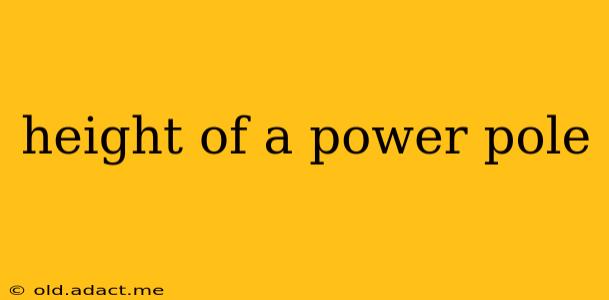Power poles, those ubiquitous structures lining our streets and countryside, come in a variety of heights depending on their purpose and location. There's no single answer to the question "What is the height of a power pole?" as many factors influence their dimensions. This guide will delve into the specifics, exploring the different types of power poles and the reasons behind their varying heights.
What Determines the Height of a Power Pole?
Several key factors determine the height of a power pole:
- Voltage: Higher voltage transmission lines require taller poles to maintain sufficient clearance from the ground and prevent accidental contact. Higher voltage lines carry more power and require greater safety margins.
- Terrain: Poles in hilly or mountainous regions may need to be taller to provide adequate clearance, even for the same voltage as poles in flatter areas.
- Location: Urban areas may necessitate shorter poles due to building heights and proximity to other structures. Rural areas often feature taller poles due to open space and the need for greater clearances from potential obstacles.
- Type of Line: Transmission lines carrying electricity over long distances are typically supported by much taller poles than distribution lines that deliver electricity to individual homes and businesses.
- Local Regulations and Codes: Building codes and regulations specific to each region will dictate minimum height requirements to ensure safety and adherence to standards.
How Tall Are Different Types of Power Poles?
Let's break down the typical heights for various types of power poles:
-
Transmission Poles (High Voltage): These are typically the tallest, ranging from 80 to 150 feet (24 to 46 meters) or even taller, depending on the voltage and terrain. They carry high-voltage electricity over long distances.
-
Distribution Poles (Medium Voltage): These are shorter than transmission poles, generally ranging from 30 to 70 feet (9 to 21 meters). They distribute electricity from substations to individual homes and businesses.
-
Streetlight Poles: These poles are much shorter and vary widely in height depending on their design and location, usually ranging from 15 to 35 feet (4.5 to 10.5 meters).
How is the Height of a Power Pole Measured?
The height of a power pole is typically measured from the ground to the top of the pole. However, this can be influenced by factors like the height of the ground itself and any additional equipment mounted on the top of the pole. Professional measurements will account for these variations.
What are the Safety Regulations Surrounding Power Pole Height?
Safety regulations concerning power pole height are crucial. Sufficient clearance must be maintained to prevent accidental contact, both for people and for aircraft. These regulations vary by location and are strictly enforced to minimize risks.
What Happens if a Power Pole is Damaged or Needs Replacement?
Damaged or outdated power poles are regularly inspected and replaced to maintain safety and grid reliability. The replacement process involves careful planning, removal of the old pole, and installation of a new one of the appropriate height and specifications.
Are There Different Materials Used for Power Poles of Varying Heights?
Yes, the material used for power poles can also influence their height and structural integrity. Common materials include wood, steel, and concrete, each with its own strength and height limitations.
This guide provides a general overview. The exact height of a power pole will depend on many site-specific factors. For detailed information relating to specific locations, consult local utility companies or relevant regulatory bodies.
